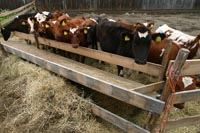New Program Allows KY Beef Producers to Make Cattle Ready for Export
New Program Allows KY Beef Producers to Make Cattle Ready for Export


Export markets for U.S. beef are demanding more detailed information about the animals from which the meat comes. A new national program was created to help U.S. beef producers document the source and age of cattle to make their herds ready for export markets.
The Beef Export Verification program will help to ensure that exported beef comes from cattle younger than 21 months of age. A similar program already exists in Kentucky called the Value-Added Targeted Marketing program. The VATM program was implemented by the University of Kentucky College of Agriculture with funds from the Kentucky Beef Network.
Through the VATM program, calves are sold in trackable lots – lots of 50 to 80 calves that move through the feedlot as a group. The calves can be sold directly or through CPH sales. Producers interested in the program place an electronic identification tag in each calf’s ear.
Cattle with electronic ID are eligible for the Beef Export Verification program. Producers who want to certify the age of their calves can do so by keeping records and participating in the Kentucky Beef Network program, said UK Agricultural Economist Lee Meyer.
“We monitor the development of the calves,” Meyer said. “When they are harvested, we send the grader into the plant to collect detailed information about the quality of the beef. Then we return that data to cattle managers and help them use the information to improve their management practices. It only costs about $10 per head fro the electronic ID and the cost of the grader. The producer splits this cost with the VATM program.”
“Currently, we are tracking about 2,000 head each year, and we’re finding that Kentucky cattle perform very well,” he said. “For example, of the cattle we’ve tracked, sickness and death loss are about one-fourth the level of a USDA cattle survey. Likewise, quality is very high. In 2004 cattle, 10 percent more graded choice than the U.S. average. Preliminary data for 2005 indicate even better results.”